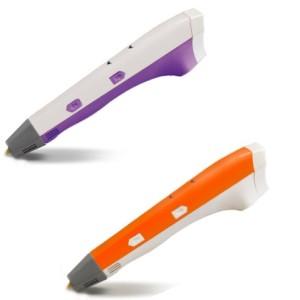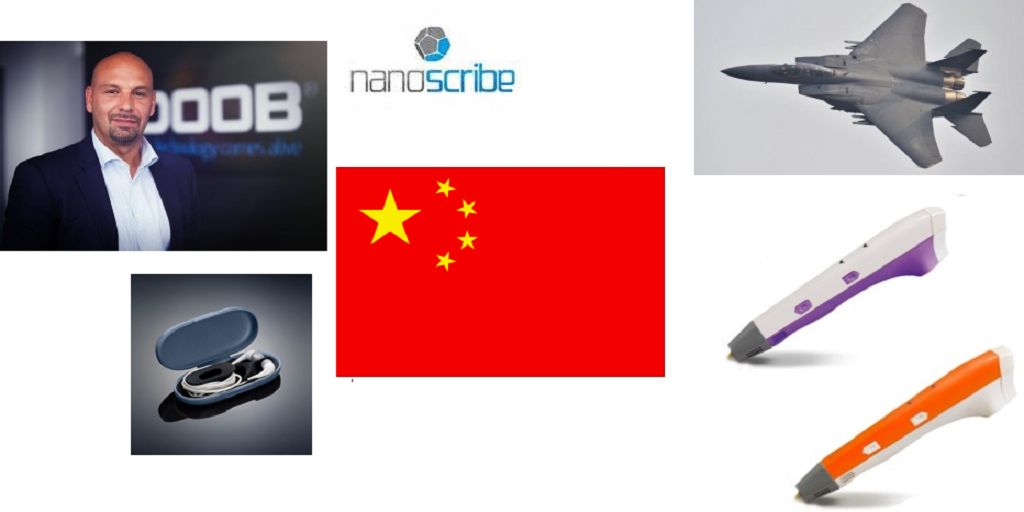December 3rd was 3D Hubs’ Global #3DPrintingDay, and when you consider that over 350 cities participated across the world, we are reminded again what an international impact 3D printing has had on many locales and industries. This week we have international news from Germany’s DOOB GROUP, Konrad Schäfer, and Nanoscribe. There’s also news about South Korea’s military using 3D printing, and the impending opening of China’s 3D Printing Innovation Center. Finally, there’s news from US-based Dim3printing.
DOOB GROUP AG Appoints New Creative Director
 The DOOB GROUP AG is a leading international 3D technology company that is headquartered in Germany with subsidiaries in Japan and the US (New York, L.A. Santa Clara, and eventually Detroit). The DOOB GROUP has built is reputation on its DOOBLICATOR and its ability to make DOOBs, which are described as “photo-realistic 3D printed replicas of our customers.” This is a high speed scanning process resulting in a 3D printed selfie replica. Customers can also count on the DOOB GROUP for its “3D tech platform” that “delivers mass customized products to consumer markets” and other sectors such as fashion, architecture, medical & healthcare, sports, entertainment and fitness.
The DOOB GROUP AG is a leading international 3D technology company that is headquartered in Germany with subsidiaries in Japan and the US (New York, L.A. Santa Clara, and eventually Detroit). The DOOB GROUP has built is reputation on its DOOBLICATOR and its ability to make DOOBs, which are described as “photo-realistic 3D printed replicas of our customers.” This is a high speed scanning process resulting in a 3D printed selfie replica. Customers can also count on the DOOB GROUP for its “3D tech platform” that “delivers mass customized products to consumer markets” and other sectors such as fashion, architecture, medical & healthcare, sports, entertainment and fitness.
Now the DOOB GROUP has announced it has a new Creative Director, Michael Michalsky, former Adidas Creative Director, who will be focusing on the company store designs, corporate identity, and international branding. If you thought that the DOOB name was already everywhere, wait until branding expert Michalsky gets ahold of the name!
Nanoscribe 3D Printers Used by Five of World’s Top Universities
 Speaking of brands, a certain 3D printer is making quite a name for itself in higher education. What do Harvard, California Institute of Technology, Oxford, ETH Zurich, and the Imperial College of London all have in common (besides being some of the world’s top places to study)? They are all institutions that have purchased Nanoscribe 3D Printers. Martin Hermatschweiler, CEO of Nanoscribe, explains the attraction to the Nanoscribe machines:
Speaking of brands, a certain 3D printer is making quite a name for itself in higher education. What do Harvard, California Institute of Technology, Oxford, ETH Zurich, and the Imperial College of London all have in common (besides being some of the world’s top places to study)? They are all institutions that have purchased Nanoscribe 3D Printers. Martin Hermatschweiler, CEO of Nanoscribe, explains the attraction to the Nanoscribe machines:
“Our systems work based on two-photon polymerization. This unique technology was only known in a specific research niche until we entered the market. Only very few researchers were familiar with this technique and there were no commercial devices. With the development of our Photonic Professional GT systems, which are today the fastest systems on the market, we could establish a new standard at universities and research institutes. In addition to the tremendous speed, they work with a precision a hundred times higher than for example stereo lithography.”
We can see that top research universities want fast, high precision micro printing with two-photon polymerization when they use 3D printers, and Nanoscribe is there to meet (and probably exceed) all of their current needs.
Dim3printing Partners with Radio Shack for Pen Release
 In news about a very different form of 3D printing than what Nanoscribe offers, Austin, Texas-based Dim3Printing LLC recently announced a partnership with Radio Shack. In fact, one of its products, a 3DFormer Drawing Pen, was featured on Radio Shack’s Black Friday materials. This pen has been a long time coming from the company, which highlights its high-quality, user-friendly features that make the pen easy to control. The affordable pen also has a unique “no-temperature adjustment for ABS and PLA compatibility with off the shelf 1.75mm ABS filaments.”
In news about a very different form of 3D printing than what Nanoscribe offers, Austin, Texas-based Dim3Printing LLC recently announced a partnership with Radio Shack. In fact, one of its products, a 3DFormer Drawing Pen, was featured on Radio Shack’s Black Friday materials. This pen has been a long time coming from the company, which highlights its high-quality, user-friendly features that make the pen easy to control. The affordable pen also has a unique “no-temperature adjustment for ABS and PLA compatibility with off the shelf 1.75mm ABS filaments.”
Amazon, Brookstone, and PCRush will also be carrying the new 3DFormer Drawing Pen.
Konrad Schäfer Adopts Stratasys’ Material, Rigur, for Manufacturing
 The automotive and aviation model manufacturer, Konrad Schäfer, has decided to use Stratasys EMEA’s “Rigur” material. Rigur is a simulated polypropylene material made for use by manufacturers in the household appliances, automotive parts, consumer goods and electronics, and lab equipment industries. It has high impact resistance and elongation at break, producing tough parts that can deflect temperatures of up to 129°F. Markus Schrӧder, a Model Building Mechanic at Konrad Schäfer, describes why the company, which manufactures prototypes for the likes of Rolls Royce, Audi, Volkswagen, and BMW, uses Rigur:
The automotive and aviation model manufacturer, Konrad Schäfer, has decided to use Stratasys EMEA’s “Rigur” material. Rigur is a simulated polypropylene material made for use by manufacturers in the household appliances, automotive parts, consumer goods and electronics, and lab equipment industries. It has high impact resistance and elongation at break, producing tough parts that can deflect temperatures of up to 129°F. Markus Schrӧder, a Model Building Mechanic at Konrad Schäfer, describes why the company, which manufactures prototypes for the likes of Rolls Royce, Audi, Volkswagen, and BMW, uses Rigur:
“Our PolyJet-based 3D Printer is used for many different rapid prototyping applications, but primarily for our customers’ extensive lighting systems, which include the front, rear and other interior/exterior requirements for all vehicle types. Needless to say that the material needed to produce these models has to be extremely tough, durable and heat-resistant, and Rigur has excelled in every department. We are now using this material across 100% of our prototyping work.”
Schrӧder also cites Rigur’s smooth surface as a big advantage since the company uses a variety of finishing methods.
China to Open 3D Printing Innovation Center
 Global manufacturing takes another leap forward as a 3D Printing Center in China, that has been in the works for a while, is set to open on a trial basis in January 2016 in the Chongqing municipality. Chinese authorities stated that the Center will develop technologies and products for aviation, automobile, and health care industries. The Center, which will be operated by the National Engineering Research Centre of Rapid Manufacturing, has investment deals with 15 companies and institutions. These deals focus on robotics and smart equipment, in addition to product development.
Global manufacturing takes another leap forward as a 3D Printing Center in China, that has been in the works for a while, is set to open on a trial basis in January 2016 in the Chongqing municipality. Chinese authorities stated that the Center will develop technologies and products for aviation, automobile, and health care industries. The Center, which will be operated by the National Engineering Research Centre of Rapid Manufacturing, has investment deals with 15 companies and institutions. These deals focus on robotics and smart equipment, in addition to product development.
South Korean Military Uses 3D Printing to Cut Expenses
 In more news from Asia, the Korea Times recently reported that 3D printing jet components cuts savings for the South Korean military by a whopping 90%! According to BBC News, it’s using the technology to “manufacture cover plates for high-pressure turbines in jet engines for its F-15K fighter aircraft, instead of ordering them directly from the United States.” The duplicate parts, originally made by General Electric, have been approved and certified, which means that it is likely South Korea will carry on with this 3D printing activity. But, due to supersonic flight’s stresses and high temperatures, not all jet parts can be 3D printed. Many still need to be made from forged titanium for strength and durability. Which of these were your favorite stories this week? Let us know in the 3D Printing Stories We’ve Missed forum on 3DPB.com.
In more news from Asia, the Korea Times recently reported that 3D printing jet components cuts savings for the South Korean military by a whopping 90%! According to BBC News, it’s using the technology to “manufacture cover plates for high-pressure turbines in jet engines for its F-15K fighter aircraft, instead of ordering them directly from the United States.” The duplicate parts, originally made by General Electric, have been approved and certified, which means that it is likely South Korea will carry on with this 3D printing activity. But, due to supersonic flight’s stresses and high temperatures, not all jet parts can be 3D printed. Many still need to be made from forged titanium for strength and durability. Which of these were your favorite stories this week? Let us know in the 3D Printing Stories We’ve Missed forum on 3DPB.com.
Subscribe to Our Email Newsletter
Stay up-to-date on all the latest news from the 3D printing industry and receive information and offers from third party vendors.
You May Also Like
Printing Money Episode 17: Recent 3D Printing Deals, with Alex Kingsbury
Printing Money is back with Episode 17! Our host, NewCap Partners‘ Danny Piper, is joined by Alex Kingsbury for this episode, so you can prepare yourself for smart coverage laced...
Insights from Cantor Fitzgerald on AM’s Q1 2024 Landscape
A recent survey by Cantor Fitzgerald sheds light on the persistent challenges within the additive manufacturing (AM) industry in the first quarter of 2024. Based on responses from 38 industry...
3D Printing Financials: Xometry’s Scaling up and Strong Start to 2024
Xometry (Nasdaq: XMTR) kicked off 2024 with strong results, boosting its marketplace and technology to new heights. Both revenue and gross margin soared, fueled by an expanding global network of...
3D Printing Financials: Desktop Metal Targets Recovery Amid Net Losses and Revenue Downturn
Despite facing a decline in revenue and the persistent challenges of a tight economic climate, Desktop Metal (NYSE: DM) is making strides toward operational efficiency. The first quarter of 2024...

































